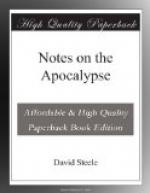Doctor M’Leod’s definition or description of the witnesses is as follows:—“They are a small company of true Christians, defending the interests of true religion against all opposition, and frequently sealing with their blood the testimony which they hold,” (p. 314.) This description is more definite than either of the two preceding, and is therefore worthy of preference; yet the reader will still wish for something more precise and tangible. Since the prophets of the Old and New Testaments reveal the hostility of the Devil to Christ and his people, and since both Daniel and John represent this hostility by appropriate and intelligible symbols, as carried out by corrupting the two great ordinances of church and state, would it not follow that the witnesses are those Christians who, for 1260 years, apply the word of God to these two ordinances, contending for a scriptural magistracy and a gospel ministry,—the “Two Sons of Oil;” and testifying against their Counterfeits? Such appears to be the import of those mystical characters of whom we read, Zech. iv. 14; Rev. xi. 4.
In tracing the witnesses through their eventful history for 1260 years as portrayed in the Apocalypse, and in fixing with precision their continuous identity, I am constrained reluctantly to dissent from the Doctor and agree with Faber. Adopting the language of “Frazer’s Key,” Dr. M’Leod says, “These witnesses differ as much from their cotemporaries, the one hundred and forty-four thousand sealed ones, (Rev. vii. 4,) as Elijah differed from the seven thousand in Israel in his time.” The attempt is made to prove this assertion by the following plausible argument:—“God is never for a moment without a people upon earth.” This is true,—“And the visible church is an indestructible society.” Is this assertion true? It is partly true, and partly untrue:—“true of her existence and moral identity, but not of her visibility as an organized body.” For example, where was the visible church while Elijah “dwelt by the brook Cherith?” (1 Kings xvii. 3, xix. 10;) or while the “woman was in the wilderness?” (Rev. xii. 6.) Is it consistent with propriety to contemplate the woman as literally visible, when she is symbolically “in the wilderness?” This seems to be impossible. I am therefore prepared to give my decided preference to the sentiment of Mr. Faber contained in the following words of his “Dissertation:” “The one hundred and forty-four thousand here mentioned, (Rev. xiv. 1,) are the immediate successors of the one hundred and forty four thousand sealed servants of God; (ch. vii. 4.) They are the same in short, as the two witnesses.... They constitute the persecuted church in the wilderness.”—I cannot but think the evidence of identity here irresistible; and in the pithy language of the Doctor on another point, I say,—“A man must shut his eyes not to see” the correctness of Mr. Faber’s




